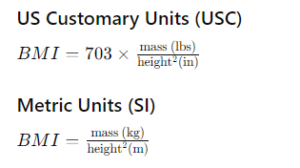A BMI (Body Mass Index) calculator is a tool used to estimate an individual’s body fat based on their weight and height. The formula used to calculate BMI is.
BMI is a measurement of a person’s leanness or corpulence based on their height and weight, intended to quantify tissue mass. It is widely used as a general indicator of whether a person has a healthy body weight for their height.
The value obtained from the calculation of BMI is used to categorize whether a person is underweight, normal weight, overweight, or obese depending on the range the value falls between. These ranges vary based on factors such as region and age and are sometimes further divided into subcategories.
Steps to Use a BMI Calculator:
- Input Weight: Enter your weight in kilograms or pounds.
- Input Height: Enter your height in meters or inches.
- Calculate: The calculator will use the appropriate formula to calculate your BMI.
BMI Categories:
- Underweight: BMI < 18.5
- Normal weight: BMI 18.5–24.9
- Overweight: BMI 25–29.9
- Obesity: BMI 30 or greater
BMI Table for Adults
World Health Organization (WHO) Recommended Body Weight
| Classification | BMI Range (kg/m²) |
|---|---|
| Severe Thinness | < 16 |
| Moderate Thinness | 16 – 17 |
| Mild Thinness | 17 – 18.5 |
| Normal | 18.5 – 25 |
| Overweight | 25 – 30 |
| Obese Class I | 30 – 35 |
| Obese Class II | 35 – 40 |
| Obese Class III | > 40 |
BMI Table for Children and Teens, Age 2-20
Centers for Disease Control and Prevention (CDC) Recommended BMI Categorization
| Category | Percentile Range |
|---|---|
| Underweight | < 5% |
| Healthy Weight | 5% – 85% |
| At Risk of Overweight | 85% – 95% |
| Overweight | > 95% |
Risks Associated with Being Overweight
Being overweight increases the risk of several serious diseases and health conditions, including:
- High blood pressure
- Higher levels of LDL cholesterol and triglycerides
- Type II diabetes
- Coronary heart disease
- Stroke
- Gallbladder disease
- Osteoarthritis
- Sleep apnea and breathing problems
- Certain cancers (e.g., endometrial, breast, colon)
- Low quality of life
- Mental illnesses (e.g., depression, anxiety)
- Body pains and physical function difficulties
- Increased risk of mortality
Risks Associated with Being Underweight
Being underweight also has associated risks, such as:
- Malnutrition, vitamin deficiencies, anemia
- Osteoporosis
- Decreased immune function
- Growth and development issues (children/teens)
- Reproductive issues for women
- Potential complications from surgery
- Increased risk of mortality
Limitations of BMI
BMI is a widely used and useful indicator of healthy body weight, but it has limitations:
- Cannot fully account for body composition
- Influenced by age, sex, ethnicity, muscle mass, and activity level
- Not fully accurate for older adults, women, muscular individuals, and children
BMI Formula
US Customary Units (USC)

BMI Prime
BMI prime is the ratio of a person’s measured BMI to the upper limit of BMI that is considered “normal” (25 kg/m²).

Weight Classification Based on BMI Prime
| Classification | BMI | BMI Prime |
|---|---|---|
| Severe Thinness | < 16 | < 0.64 |
| Moderate Thinness | 16 – 17 | 0.64 – 0.68 |
| Mild Thinness | 17 – 18.5 | 0.68 – 0.74 |
| Normal | 18.5 – 25 | 0.74 – 1 |
| Overweight | 25 – 30 | 1 – 1.2 |
| Obese Class I | 30 – 35 | 1.2 – 1.4 |
| Obese Class II | 35 – 40 | 1.4 – 1.6 |
| Obese Class III | > 40 | > 1.6 |
Ponderal Index
The Ponderal Index (PI) measures leanness or corpulence similar to BMI but cubes the height in the formula. It is more reliable for very tall or short individuals.



